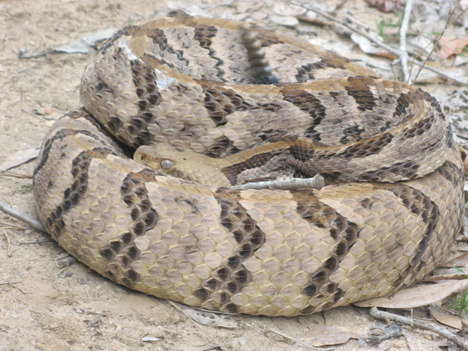
Snakes are out; be careful
By Stan Kirkland, Florida Fish and Wildlife Conservation Commission
Phil Manor remembers the day like it was yesterday. It was late spring in 1993 when he was working by himself on the Apalachicola River Wildlife and Environmental Area tearing out a beaver dam on a wetland.
Manor, who at the time had worked four years as a wildlife biologist with the Florida Game and Fresh Water Fish Commission, was almost through with his work when a 2.5- to-3-foot-long cottonmouth struck the index finger on his left hand. Almost immediately his finger and hand began to throb and burn.
Manor knew he had to get to a doctor. He cranked up his four-wheeler, drove himself to the Howard Creek compound and in a few minutes was at Gulf Pines Hospital in Port St. Joe. He was given five vials of antivenin to negate the effects of the venomous bite but it took weeks for the swelling to go down in his left hand.
Every year across the United States an estimated 7,000-8,000 people are bitten by venomous snakes. About five people die from the bites, according to the Centers for Disease Control and Prevention.
While most people see snakes around water and automatically assume they are cottonmouths, that’s generally not the case, said Dr. John Himes, a wildlife biologist with the Florida Fish and Wildlife Conservation Commission (FWC).
“Probably 80 percent to 90 percent of the snakes people see in and around water are harmless water snakes,” Himes said. “If you pick them up, they may bite because they don’t like being handled but they are not venomous.”
Himes said both cottonmouths and the five species of water snakes found in the Panhandle play an important ecological role by feeding on dead or dying fish, amphibians and small invertebrates.
Guides to venomous snakes:
Click here for guide to venomous snakes
Click here for guide to nonveneomous snakes
All told, there are only six species of venomous snakes and more than 40 non- venomous species found in Florida. In addition to the cottonmouth, the list of venomous snakes includes the canebrake rattlesnake, Eastern diamondback, pygmy rattlesnake, copperhead and coral snake.
The canebrake, also called a timber rattler, is the rarest of the group. Specimens are occasionally found in Northwest Florida from the Olustee area to Alachua County. Canebrakes are more common in Georgia and Alabama and Southeastern states.
The more common venomous snakes in Florida include the cottonmouth, Eastern diamondback and pygmy rattlesnakes. The latter two are usually found in more rural settings where there’s ample cover.
Himes said copperheads are expertly camouflaged.
Coral snakes are the only species of the group whose venom affects the central nervous system. They have small fangs, in comparison with the other venomous snakes, and coral snake bites are fairly rare.
“Coral snakes are inoffensive and almost secretive,” Himes said. “You find them around yard litter or decaying leaves and such, but if a person wears gloves to do their yard work, they have nothing to fear from this snake.”
Although many people are afraid of all snakes, Himes said it’s important to remember venomous and nonvenomous species play an important role in the environment by preying on rats, mice, small reptiles and amphibians, rabbits and even each other in some cases.
